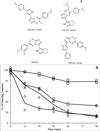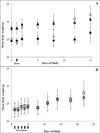Toxicity, pharmacokinetics and metabolism of a novel inhibitor of IL-6-induced STAT3 activation
- PMID: 27778071
- PMCID: PMC5115981
- DOI: 10.1007/s00280-016-3181-9
Toxicity, pharmacokinetics and metabolism of a novel inhibitor of IL-6-induced STAT3 activation
Abstract
Purpose: The oncogenic transcription factor signal transducer and activator of transcription 3 (STAT3) promotes gene transcription involved in cancer, and its activation by IL-6 is found in head and neck squamous cell carcinoma. Four triazolothiadizine STAT3 pathway inhibitors were evaluated to prioritize a single compound for in vivo examination.
Methods: Metabolic stability in mouse liver microsome incubation was used to evaluate four triazolothiadizine analogues, and UPCDC-10205 was administered to mice IV as single or multiple doses to evaluate toxicity. Single-dose pharmacokinetics (PK), bioavailability and metabolism were studied after IV 4 mg/kg, PO 4 mg/kg, or PO 30 mg/kg suspension in 1% carboxymethyl cellulose. Mice were euthanized between 5 min to 24 h after dosing, and plasma and tissues were analyzed by LC-MS. Non-compartmental PK parameters were determined.
Results: Of the four triazolothiadizine analogues evaluated, UPCDC-10205 was metabolically most stable. The maximum soluble dose of 4 mg/kg in 10% Solutol™ was not toxic to mice after single and multiple doses. PK analysis showed extensive tissue distribution and rapid plasma clearance. Bioavailability was ~5%. A direct glucuronide conjugate was identified as the major metabolite which was recapitulated in vitro.
Conclusions: Rapid clearance of UPCDC-10205 was thought to be the result of phase II metabolism despite its favorable stability in a phase I in vitro metabolic stability assay. The direct glucuronidation explains why microsomal stability (reflective of phase I metabolism) did not translate to in vivo metabolic stability. UPCDC-10205 did not demonstrate appropriate exposure to support efficacy studies in the current formulation.
Keywords: IL-6; LC-MS; Pharmacokinetics; Small molecule inhibitor of STAT3.
Figures




Similar articles
-
Evaluation of the cassette dosing approach for assessing the pharmacokinetics of geldanamycin analogues in mice.Cancer Chemother Pharmacol. 2004 Dec;54(6):475-86. doi: 10.1007/s00280-004-0853-7. Epub 2004 Jul 29. Cancer Chemother Pharmacol. 2004. PMID: 15526201
-
HCS campaign to identify selective inhibitors of IL-6-induced STAT3 pathway activation in head and neck cancer cell lines.Assay Drug Dev Technol. 2015 Sep;13(7):356-76. doi: 10.1089/adt.2015.663. Assay Drug Dev Technol. 2015. PMID: 26317883 Free PMC article.
-
NTP technical report on the toxicity and metabolism studies of chloral hydrate (CAS No. 302-17-0). Administered by gavage to F344/N rats and B6C3F1 mice.Toxic Rep Ser. 1999 Aug;(59):1-66, A1-E7. Toxic Rep Ser. 1999. PMID: 11803702
-
The IL-6/JAK/STAT3 pathway: potential therapeutic strategies in treating colorectal cancer (Review).Int J Oncol. 2014 Apr;44(4):1032-40. doi: 10.3892/ijo.2014.2259. Epub 2014 Jan 15. Int J Oncol. 2014. PMID: 24430672 Review.
-
Preclinical pharmacokinetics: an approach towards safer and efficacious drugs.Curr Drug Metab. 2006 Feb;7(2):165-82. doi: 10.2174/138920006775541552. Curr Drug Metab. 2006. PMID: 16472106 Review.
Cited by
-
Antiplatelet and Antithrombotic Properties of Compound L-36, a 6H-1,3,4-Thiadiazine Derivative.Bull Exp Biol Med. 2024 May;177(1):63-67. doi: 10.1007/s10517-024-06132-w. Epub 2024 Jul 2. Bull Exp Biol Med. 2024. PMID: 38954300
-
Yidu-toxicity blocking lung decoction ameliorates inflammation in severe pneumonia of SARS-COV-2 patients with Yidu-toxicity blocking lung syndrome by eliminating IL-6 and TNF-a.Biomed Pharmacother. 2020 Sep;129:110436. doi: 10.1016/j.biopha.2020.110436. Epub 2020 Jun 19. Biomed Pharmacother. 2020. PMID: 32768938 Free PMC article. Clinical Trial.
-
Chemical modulation of transcription factors.Medchemcomm. 2018 Jul 11;9(8):1249-1272. doi: 10.1039/c8md00273h. eCollection 2018 Aug 1. Medchemcomm. 2018. PMID: 30151079 Free PMC article. Review.
-
Liquid chromatography-tandem mass spectrometric assay for the quantitation of the novel radiation protective agent and radiation mitigator JP4-039 in murine plasma.J Pharm Biomed Anal. 2018 Feb 20;150:169-175. doi: 10.1016/j.jpba.2017.12.023. Epub 2017 Dec 12. J Pharm Biomed Anal. 2018. PMID: 29245086 Free PMC article.
-
Dose-dependent bioavailability, absorption-rate limited elimination, and tissue distribution of the ATR inhibitor BAY-1895344 (elimusertib) in mice.Cancer Chemother Pharmacol. 2022 Jun;89(6):795-807. doi: 10.1007/s00280-022-04436-0. Epub 2022 May 4. Cancer Chemother Pharmacol. 2022. PMID: 35507041 Free PMC article.
References
-
- Argiris A. EGFR inhibition for recurrent or metastatic HNSCC. The Lancet Oncology. 2015;16(5):488–489. - PubMed
-
- Frank DA. STAT3 as a central mediator of neoplastic cellular transformation. Cancer letters. 2007;251(2):199–210. - PubMed
-
- Wang X, Crowe PJ, Goldstein D, Yang JL. STAT3 inhibition, a novel approach to enhancing targeted therapy in human cancers (review) International journal of oncology. 2012;41(4):1181–1191. - PubMed
MeSH terms
Substances
Grants and funding
LinkOut - more resources
Full Text Sources
Other Literature Sources
Miscellaneous

